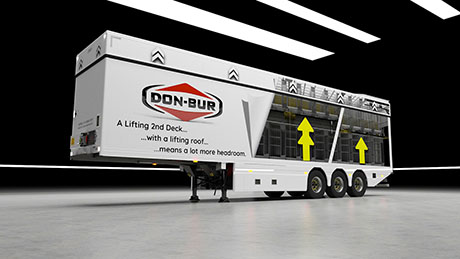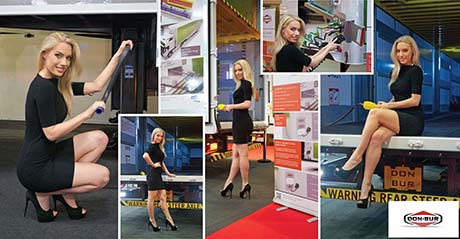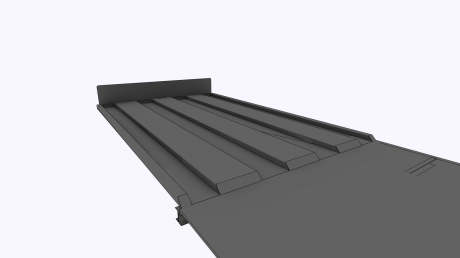Today's operators are buying 'smarter' and, at this year's CV Show on stand 5A50, Don-Bur are launching a host of innovative products and features that not only excite the imagination of cost-conscious Fleet Managers, they can be applied to fleets in a practical way with sound business cases to back them up.
Press Release
Issued: 24th April 2018 - For Immediate General Release
Don-Bur: 'Full of Smart' at the 2018 Commercial Vehicle Show
Today's operators are buying 'smarter' and, at this year's CV Show on stand 5A50, Don-Bur are launching a host of innovative products and features that not only excite the imagination of cost-conscious Fleet Managers, they can be applied to fleets in a practical way with sound business cases to back them up.
First, and taking pride of place on the Don-Bur stand, is the biggest and arguably smartest and safest trailer on the UK roads. Since their introduction in 2012, Longer Semi Trailers (LSTs) have already been proven to save an average of 1 in every 19 journeys (5%) and the trial is reported to have reduced freight kilometers by a minimum of 15.1 million*. The max cube, 60 UK pallet footprint exhibit is one of 25 such trailers being built for Argos and is the biggest possible example of its kind. At 4.88m high, 15.65m long (2.050m longer) and incorporating a low height, step-frame chassis, this Don-Bur behemoth carries a gaping cubic volume of 145.5m3; 16% bigger than its standard length (13.6m) counterpart. With efficient fill ratios, this trailer could reduce journeys by 2 legs in every 13.
The tri-axle "Blade™" panel box van construction is also fitted with a ¾ length 10T capacity Lifting Deck; fabricated to provide 2.42m across its width which provides the facility to load two UK pallets with their longest length across the width. The deck is powered by Don-Bur's original design single-ram-and-pulley system which continues to be the most durable and reliable lifting method.
Exclusive to Don-Bur, Blade™ composite panels are just 7.5mm thick and weigh just 11.8kgs per m2. The recyclable panel consists of an HDPE (High Density Polyethylene) foam core and is faced with 0.5mm 80,000 psi yield galvanised steel. Finished with a baked-on polyester coating, the result is a lightweight panel that doesn't delaminate and has exceptional protection against impact, abrasion, puncture and corrosion.
The Lifting Deck is complemented by an additional fixed second deck fitted over the swan-neck area to provide the full 60 UK pallet capacity. By lowering floor height on the 6 off 445/45 R19.5 wheels and minimising the thickness of decks, a generous aperture of 1.87m (6' 1 ½") high has been achieved on both decks which provides ample head room when loading or unloading.
The running gear comprises two bogies including a fixed 18T tandem set and a self-steer rear 10T axle set further back to avoid bogie overload.
In addition to the efficiency benefits gained via cube, Don-Bur is showcasing an array of smart safety features on the show exhibit trailer; two of which are new, patent pending Don-Bur inventions. They include:
'EBS-Safe'
ISO 7638 Connection Warning System - Don-Bur recently became alarmingly aware that the incidence of a failed EBS connection in transit was higher than previously imagined. The trait was originally discovered via a thorough investigation within a blue chip fleet with detailed telematics data which highlighted a rate of 36.5 incidents per week over a given period where the EBS connection was either faulty or non-existent.
So why is this such an important discovery? For starters, it is a legal requirement to connect the ISO 7638 EBS/ABS line, and for very good reason. The ABS/EBS power and 'CAN' data both control critical trailer features including anti-lock braking, braking response time, progressive brake pressure relative to weight, roll stability control and suspension height. Whilst the latter doesn't sound too serious, consider the implications of a double deck trailer with high lift suspension and only 3 inches of clearance under bridges at ride height.
There are a number of reasons why a valid ISO 7638 connection might not be present. Most simply, the driver may not have connected it. The cab EBS fuse may have blown. The EBS wiring/connections may be old or damaged with extended use. Lastly, because of the similarity between the tractor plug connection and the plug that is stowed in the dummy socket holder (for the loose end that is supposed to be connected to the trailer), the driver may be grasping the wrong end from the back of the tractor and connecting it to the trailer. It will look right but has no power. Regrettably, there are a number of routes to failure.
How then, is the driver meant to know if a problem exists? The obvious response might be the EBS warning light in the cab, but this could be easily ignored; especially, if "it's always coming on." On some older tractors, you don't even get this luxury.
Don-Bur has developed a system, dubbed 'EBS-Safe' (Patent applied for), that detects if a valid ISO 7638 EBS/ABS connection is present. Quite simply, if the driver starts plugging in the electrical lines but doesn't get a valid ISO 7638 EBS/ABS connection, they'll be sufficiently alerted by a warning light on the front bulkhead and a 90dB siren. The light is even placed at a height and position to match the view in the driver's mirror. Once the ISO 7638 connection is made, the warning stops and all ABS/EBS functions resume.
'Leg-Safe' - Landing Leg Safety System
The "dropping" of a trailer is caused by drivers failing to lower the landing legs during the de-coupling process; often when tired or distracted. The result is that the tractor pulls away and the front of the trailer drops a significant distance before the landing leg feet crash into the road/bay surface.
The consequences can be severe. Don-Bur carried out an assessment based on an average 26,500kgs load on a standard 13.7m long trailer. 8,050kgs of that is placed in front of the landing legs. If you allow a trailer to drop just 40mm before impact (The travel of landing legs is typically 250-300mm), the generated kinetic energy is equivalent to a weight of 64,356 kgs. Under such loads, the obvious consequence is damage to the road/bay surface, deformation of the landing leg feet and potential damage to the payload inside. What is perhaps less obvious, but arguably more serious, is the potential for warping and stress fractures in the trailer neck itself. Over time, this type of damage can require significant repairs and, gone unnoticed, could result in disastrous accidents.
The next Don-Bur invention, "Leg-Safe" (Patent applied for), provides an elegant solution to this problem. When de-coupling, the system senses the position of the legs and warns the driver (visual and audible) that they have not been suitably lowered. Conversely, when coupling and the legs have not been raised, the system will alert the driver to raise the legs to a suitable height to avoid damaging them on a raised road surface during transit.
As the system requires a series of sensors to operate, the Leg-Safe system also doubles as a system to enforce correct coupling procedures. If your landing legs are fully lowered, it goes without saying that your air and electrical lines shouldn't be coupled so the warning serves to ensure that lines don't get damaged if the driver pulls away prematurely. The opposite benefit applies where the landing legs are raised and no 'Suzie' lines are connected. In this scenario the system expects that all the lines should be connected correctly and the warning encourages this.
'View-Safe'
Visibility is key to drivers when manoeuvring; particularly when reversing. Don-Bur has fitted a version of their 'View-Safe' system which incorporates 4 strategically placed, downward facing cameras. When reversing, the live feed from each of these cameras is stitched together to form a complete 360˚ birds eye view of the area surrounding the vehicle.
'Turn-Safe'
Although every effort can be made to improve visibility for HGVs, pedestrians and cyclists are not necessarily as aware of these challenges as the driver is. Also fitted to the Argos LST exhibit is the Don-Bur 'Turn-Safe' system. Several limited distance proximity detectors are positioned along each side of the trailer and if the driver signals left or right, the relevant side detects pedestrians and/or cyclists and sets off an audible alarm to alert them of the potential danger. An additional beeper would be fitted inside the cab to alert the driver.
The 'Turn-Safe' system is coupled with cyclist high visibility hazard tape applied to the side guard area and a warning sticker applied to the rear doors.
Combined Marker/ Indicators
To complement the 'Turn-Safe' system, Don-Bur has also fitted combined side marker/ indicator lamps which are again designed to alert pedestrians and cyclists to a potentially hazardous manoeuvre.
'Reverse-Safe'
Reversing is one of the most hazardous manoeuvres a driver can make. Active when reversing, the system fitted to the exhibit trailer combines both a visual cue for the driver to see how close they are to an object and a mechanical brake interlock that activates automatically if the rear of the trailer gets too close (50-200cm) to something.
'Banksman' Lighting
It's a great shame that headlights aren't currently able to swivel round through 180˚ to point backwards when reversing. In poorly lit points of delivery, the lack of lighting adds to the already challenging task of lining a trailer up to a bay or simply manoeuvring around a yard. 'Banksman' lighting is a series of down-facing lights positioned strategically under each side rave. When reversing (or at low forward speeds), these lights provide an unbroken pool of light to both sides; improving visibility and reducing the risk of accident.
'LowGlide'
'LowGlide'is Don-Bur's patented and award-winning safe ground level coupling system. A unique sliding arm assembly provides the capability for the driver to couple up comfortably at the side of the trailer without having to access the dangerous catwalk area between the back of the cab and the front of the trailer. The coupling plate is presented at chest height for convenience so the driver can apply adequate pressure to the airline couplings without stretching or twisting. When coupled, the coupling plate simply slides back to a central transit position. The feature not only eliminates risks associated with catwalk access but also deters the need for the frowned-upon practice of 'split coupling'.
Aerodynamic Configurator for Transport (ACT)
Being launched for the first time at the Commercial Vehicle Show 2018 is an Innovate UK funded 'Smart' tool set which can be relied upon by operators to build a robust and plausible business case for the investment into aerodynamic based fuel and CO2 reducing improvements.
For many years, Don-Bur has been synonymous with innovative aerodynamic solutions; however, despite the wealth of trial data (both at proving grounds and real-world operator feedback) available to operators about the relative merits of various aerodynamic "widgets", the obvious and sometimes significant benefits don't necessarily entice a purchasing decision away from anything but the most basic of tractor/trailer designs.
The reason for this apparent apathy is perhaps understandable. For years, numerous manufacturers have been making claims with various degrees of proof or validation. As for translating a potential fuel saving claim into a proven fleet saving, this would only be possible if you had historical fleet data for an aerodynamic intervention you hadn't implemented yet; until now.
The ACT project is being driven by a consortium, bringing together stakeholders that represent the apex of each field of knowledge required to realise the project:
TotalSim Ltd are aerodynamic experts, specialising in Computational Fluid Dynamics (CFD). Their reputation and experience within the automotive industry are second to none and they are commonly associated with Formula 1 and premium automotive development and design. They provide the core backbone of the project; an independent, unbiased data set to illustrate the relative advantages or disadvantages of any aerodynamic product or, perhaps more interestingly, concept.
Dynamon Ltd is a specialist data analysis house, specifically targeted to reducing fuel costs and emissions within the logistics industry. Their understanding is not just limited to aerodynamic influence. In order to bring about a complete holistic solution, Dynamon also factor in accurate fleet data for tyre performance, weight, driver performance, traffic, landscape, weather, vehicle size, engine efficiency, lubricants and fuels.
Don-Bur (Bodies & Trailers) Ltd are already recognised for their work in aerodynamic HGVs but are also well-placed to provide key information about regulations, build limitations, design influences and, perhaps most critically, costs.
Two operators also join as major contributors (Wincanton and Truswell Haulage); each targeted toward opposite ends of the logistics spectrum and each providing critical telematics data relating to real-world logistics. Along with a leading HGV aerodynamic device supplier (Hatcher Components), who can directly supply products developed using this technology in the future, ACT becomes an applied science which can benefit the industry as a whole.
So what does ACT actually do? In a nutshell, it examines an aerodynamic device as part of an overall tractor/trailer combination, analyses its overall drag effect, compares that force against all other fuel-affecting factors, factors in fleet-specific data such as GPS location and prevailing weather and then applies the resultant fuel effect to an operator's fleet together with the overall cost of achieving that.
Most impressively though, once you've done that with one aerodynamic device, an operator can simply add, remove or amend any combination of a huge library of aerodynamic devices, including conceptual products, until the best, most cost-effective blend is achieved.
ACT will be demonstrated on the Don-Bur stand, together with a working story of how it could be applied to our exhibit trailer. Will a set of side skirts generate a net financial benefit within a two year period or can the same effect be achieved by simply closing the cab gap by just 20mm? It may be that a far greater bonus is available simply by raising the cab top deflector through 5˚.
As we alluded to earlier, the market no longer tolerates a 'suck-it-and-see' attitude when considering the purchase of aerodynamic interventions. Buyers are being ever-driven to reduce capital/lease cost for shortening contracts and those influencing specification need to be absolutely confident about added benefit and payback times for anything which might increase that baseline cost.
ACT is the ideal industry platform to separate the wheat from the chaff and make sound business choices. The impartial and scientifically-based results can be used as a solid foundation for business cases to invest in aerodynamic fleet development and improvement.
In response to smarter buying practices, Don-Bur are providing smart solutions.
*data from latest 2016 Risk Solutions annual LST Trial Evaluation report.
- Ends -
Media
This media library is no longer available
Notes to Editors
Media Contacts:
Don-Bur | Richard Owens | +44(0)7891 405 600 | richard.owens@donbur.co.uk
TotalSim | John Iley | +44(0)7500 038 847 | john@totalsim.co.uk
Dynamon | Angus Webb | +44(0)7732 773 558 | angus@dynamon.co.uk
We’d love to hear from you – get in touch today!






